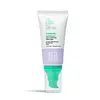What's inside
What's inside
 Key Ingredients
Key Ingredients

 Benefits
Benefits

 Concerns
Concerns

 Ingredients Side-by-side
Ingredients Side-by-side

Water
Skin ConditioningDicaprylyl Carbonate
EmollientEthylhexyl Methoxycinnamate
UV AbsorberPropanediol
SolventDibutyl Adipate
EmollientButyl Methoxydibenzoylmethane
UV AbsorberEthylhexyl Triazone
UV AbsorberBis-Ethylhexyloxyphenol Methoxyphenyl Triazine
Skin ConditioningC20-22 Alkyl Phosphate
EmulsifyingC20-22 Alcohols
Emulsion StabilisingBenzotriazolyl Dodecyl P-Cresol
UV AbsorberPolyacrylate Crosspolymer-6
Emulsion StabilisingCaprylyl/Capryl Glucoside
Cleansing1,2-Hexanediol
Skin ConditioningPanthenol
Skin ConditioningAllantoin
Skin ConditioningParfum
MaskingPhysalis Angulata Extract
Skin ProtectingTocopheryl Acetate
AntioxidantXanthan Gum
EmulsifyingCaprylic/Capric Triglyceride
MaskingDisodium EDTA
Sodium Hydroxide
BufferingO-Cymen-5-Ol
AntimicrobialSodium Hyaluronate
HumectantBHT
AntioxidantTocopherol
AntioxidantPantolactone
HumectantCI 19140
Cosmetic ColorantCI 42090
Cosmetic ColorantWater, Dicaprylyl Carbonate, Ethylhexyl Methoxycinnamate, Propanediol, Dibutyl Adipate, Butyl Methoxydibenzoylmethane, Ethylhexyl Triazone, Bis-Ethylhexyloxyphenol Methoxyphenyl Triazine, C20-22 Alkyl Phosphate, C20-22 Alcohols, Benzotriazolyl Dodecyl P-Cresol, Polyacrylate Crosspolymer-6, Caprylyl/Capryl Glucoside, 1,2-Hexanediol, Panthenol, Allantoin, Parfum, Physalis Angulata Extract, Tocopheryl Acetate, Xanthan Gum, Caprylic/Capric Triglyceride, Disodium EDTA, Sodium Hydroxide, O-Cymen-5-Ol, Sodium Hyaluronate, BHT, Tocopherol, Pantolactone, CI 19140, CI 42090
Butylene Glycol
HumectantAlcohol Denat.
AntimicrobialGlycerin
HumectantCarbomer
Emulsion StabilisingPolyglyceryl-4 Caprate
EmulsifyingPhenoxyethanol
PreservativeCaprylyl Glycol
EmollientTocopheryl Acetate
AntioxidantSodium Hydroxide
BufferingSodium Hyaluronate
HumectantParfum
MaskingSalicylic Acid
MaskingTrisodium Ethylenediamine Disuccinate
Benzyl Benzoate
AntimicrobialRubus Idaeus Juice
AstringentBenzyl Alcohol
PerfumingGeraniol
PerfumingLinalool
PerfumingLimonene
PerfumingHydroxycitronellal
PerfumingSodium Benzoate
MaskingAlpha-Isomethyl Ionone
PerfumingPotassium Sorbate
PreservativeCI 14700
Cosmetic ColorantButylene Glycol, Alcohol Denat., Glycerin, Carbomer, Polyglyceryl-4 Caprate, Phenoxyethanol, Caprylyl Glycol, Tocopheryl Acetate, Sodium Hydroxide, Sodium Hyaluronate, Parfum, Salicylic Acid, Trisodium Ethylenediamine Disuccinate, Benzyl Benzoate, Rubus Idaeus Juice, Benzyl Alcohol, Geraniol, Linalool, Limonene, Hydroxycitronellal, Sodium Benzoate, Alpha-Isomethyl Ionone, Potassium Sorbate, CI 14700
Ingredients Explained
These ingredients are found in both products.
Ingredients higher up in an ingredient list are typically present in a larger amount.
Parfum is a catch-all term for an ingredient or more that is used to give a scent to products.
Also called "fragrance", this ingredient can be a blend of hundreds of chemicals or plant oils. This means every product with "fragrance" or "parfum" in the ingredients list is a different mixture.
For instance, Habanolide is a proprietary trade name for a specific aroma chemical. When used as a fragrance ingredient in cosmetics, most aroma chemicals fall under the broad labeling category of “FRAGRANCE” or “PARFUM” according to EU and US regulations.
The term 'parfum' or 'fragrance' is not regulated in many countries. In many cases, it is up to the brand to define this term.
For instance, many brands choose to label themselves as "fragrance-free" because they are not using synthetic fragrances. However, their products may still contain ingredients such as essential oils that are considered a fragrance by INCI standards.
One example is Calendula flower extract. Calendula is an essential oil that still imparts a scent or 'fragrance'.
Depending on the blend, the ingredients in the mixture can cause allergies and sensitivities on the skin. Some ingredients that are known EU allergens include linalool and citronellol.
Parfum can also be used to mask or cover an unpleasant scent.
The bottom line is: not all fragrances/parfum/ingredients are created equally. If you are worried about fragrances, we recommend taking a closer look at an ingredient. And of course, we always recommend speaking with a professional.
Learn more about ParfumSodium Hyaluronate is hyaluronic acid's salt form. It is commonly derived from the sodium salt of hyaluronic acid.
Like hyaluronic acid, it is great at holding water and acts as a humectant. This makes it a great skin hydrating ingredient.
Sodium Hyaluronate is naturally occurring in our bodies and is mostly found in eye fluid and joints.
These are some other common types of Hyaluronic Acid:
Learn more about Sodium HyaluronateSodium Hydroxide is also known as lye or caustic soda. It is used to adjust the pH of products; many ingredients require a specific pH to be effective.
In small amounts, sodium hydroxide is considered safe to use. However, large amounts may cause chemical burns due to its high alkaline.
Your skin has a natural pH and acid mantle. This acid mantle helps prevent harmful bacteria from breaking through. The acid mantle also helps keep your skin hydrated.
"Alkaline" refers to a high pH level. A low pH level would be considered acidic.
Learn more about Sodium HydroxideTocopheryl Acetate is AKA Vitamin E. It is an antioxidant and protects your skin from free radicals. Free radicals damage the skin by breaking down collagen.
One study found using Tocopheryl Acetate with Vitamin C decreased the number of sunburned cells.
Tocopheryl Acetate is commonly found in both skincare and dietary supplements.
Learn more about Tocopheryl Acetate